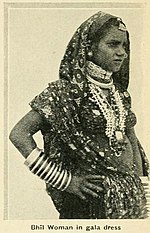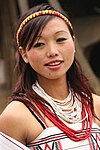|
Bhil
Bhil or Bheel refer to the various indigenous groups inhabiting western India, including parts of Rajasthan and Madhya Pradesh and are also found in distant places such as Bengal and Tripura.[4] They speak various dialects of regional Indo-Aryan languages, collectively referred to as the Bhil languages, while the indigenous non-Indo-Aryan language that the Bhil originally spoke is lost.[5][6] Bhils are divided into a number of endogamous territorial divisions, which in turn have a number of clans and lineages. Bhils are listed as tribal people in the states of Gujarat, Madhya Pradesh, Chhattisgarh, Maharashtra and Rajasthan—all in the western Deccan regions and central India—as well as in Bengal and Tripura in far-eastern India, on the border with Bangladesh. Many Bhils now speak the dominant later language of the region they reside in, such as Marathi, Gujarati, Bengali or a Bhili language dialect. EtymologySome scholars suggest that the term Bhil is derived from the word billa or billu which means bow in the Dravidian lexis. The term Bhil is used to refer to "various ethnic communities" living in the forests and hills of Rajasthan's southern parts and surrounding regions of western India, highlighting the "popularity of the bow and arrow as a weapon among these groups". It is also used as a blanket term to refer to the aboriginal peoples of these areas.[4] HistoryAccording to John Samuel, as per legendary and historical records, the Bhil tribals controlled large parts of Gujarat from 11th to 15th century before the Rajputs conquered the territories from these locals.[7] Bhil RebellionThe Bhils of what is now the state of Gujarat rebelled on several occasions during the British colonial era, notably in 1846, 1857–58 and 1868.[8] Along with a number of other Indian social groups, the Bhils were designated as a criminal tribe by the British colonial government under the Criminal Tribes Act 1871, which meant that a Bhil could be "randomly picked up, tortured, maimed or even killed" by the colonial authorities. Susan Abraham notes that many of the tribes characterised as criminal under the Act had earlier rebelled against the East India Company and participated in the Indian Rebellion of 1857. She claims that the British colonial government legislated the Act in 1871 in the wake of these autochthonic tribes' proclivity for rebellion.[9] Mutiny against Mewar State According to Ram Pande, in 1881, the Bhils protested against "the census classification, prohibition on alcohol manufacture, establishment of police and customs, and the ban on the killing of witches". Their campaigning was stepped up and given meaning by Govind Guru who was a social and political leader. Pande suggests that because of his long-term Brahminical Hinduism missionary work among the tribe, Govind was able to stop them consuming meat and alcohol, and to pressurise the state for the formation of village councils which could administer their own affairs and for barring forced labour. In 1917, Mewar State's Girasias joined the Bhils in the struggle to get the petty taxes and forced labour quashed, and to get the land revenues decreased. Taking note of these protests, the jagirdars of Mewar had called on a British political agent to suppress the mutiny. Pande noted that 1,500 Bhils got shot in 1913. In 1921, the tribals and peasants united under the leadership of Motilal Tejawat in the struggle against "forced labour, petty taxes, the disparity in taxes, high taxes and the tyrannical ways of the jagirdars". Tejawat's thoughts drew followers from the Bhils and Girasias of the Danta, Idar, Palanpur and Sirohi regions of Gujarat; and he "became a notorious offender against the state".[10] DemographicsThe Bhils are inhabitants of Dhar, Jhabua, Khargone and Ratlam districts of Madhya Pradesh. Bhilai (Bhil= Tribe, Aai= Came, meaning Bhils came), a city in Durg district of Chhattisgarh is named after this.[citation needed] A large number of Bhils live in the neighbouring states of Maharashtra, Gujarat and Rajasthan. In Bengal, the Bauris represent the Bhil tribe.[11][better source needed] They constitute the largest tribe of India. According to Victoria R. Williams, the Bhils are India's "most widely dispersed tribal group". A small population of Bhils also resides in Pakistan's Sindh province, who are known as the Sindhi Bhils.[12] Present circumstancesThe Bhil are classified as a Scheduled Tribe in Andhra Pradesh, Chhattisgarh, Gujarat, Karnataka, Madhya Pradesh,[13] Maharashtra, Rajasthan and Tripura under the Indian government's reservation program of positive discrimination.[1] SubdivisionsThe Bhil are divided into a number of endogamous territorial divisions, which in turn have a number of clans and lineages. In Rajasthan, they exist as Bhil Garasia, Dholi Bhil, Dungri Bhil, Dungri Garasia, Mewasi Bhil, Barda, Patelia, Warli, Bagdi,[14] Dhodia, Bhillava or Billava, Barela, Khotil, Dangchai,[15] Dangehi, Nirdhi Bhil, Gamit, Rawal Bhil, Tadvi Bhil, Bhagalia, Bauris, Bhilala, Rathwa,[16] Pawra, Barda, Warli, Nayak,[17] Nahals, Mathvadi, Dorepis,[18] Dhanka,[19] Vasava and Vasave.[20][a] Language The language commonly spoken by Bhils throughout their geographic distribution is Bhili.[21] Bhili has about up to 36 identified dialects and pronunciation differs by region.[21][22] Bhili is based on Gujarati, but dialects of Bhili gradually merge into more widely spoken languages such as Marathi in the southeast and Rajasthani in the northwest. Around 10 million people recorded themselves as speaking a Bhili dialect in the census.[23] Estimates of individuals speaking the language are often inaccurate as speakers of minor languages like Bhili have sometimes been treated as having major languages (such as Marathi or Gujarati) as their mother tongue.[24] The Bhils in Sindh speak Sindhi Bhili and Dhatki.[25] Culture and TraditionsBhils have a rich and unique culture. The Bhilala sub-division is known for its Pithora painting.[26] Ghoomar is a traditional folk dance of the Bhil tribe.[27][28] Ghoomar is the symbol of womanhood. Young girls take part in this dance and declare that they are stepping into the shoes of women. ArtBhil painting is characterised by the use of multi-coloured dots as in-filling. Bhuri Bai was the first Bhil artist to paint using readymade colours and paper. Other known Bhil artists include Lado Bai, Sher Singh, Ram Singh and Dubu Bariya.[29] FoodMain foods of Bhils are maize, onion, garlic and chili which they cultivate in their small fields. They collect fruits and vegetables from the local forests. Wheat and rice are used at time of festivals and other special occasions only. They keep self-made bows and arrows, swords, knives, axes etc. with them as weapons for self-defense and hunting the wild fauna which also form the major part of their diet. They profusely use alcohol distilled by them from the flower of Mahua (Madhuca longifolia). On festive occasions, various special preparation from the dish rich, i.e. maize, wheat, barley, malt and rice. Bhils are traditionally non-vegetarian.[30] Dress The traditional dresses of men are the Pagri, Angarkha, Dhoti and Gamchha. Traditionally women wear Sari and Ghagra Choli. There are many traditional ornaments of Bhils. Men wear Kada, Bajuband, Chain, ear rings, Kardhani. Women wear variety of ornaments such as hansli (ring) Zele-zumke, earring in Bhil language, narniyan[what language is this?] (bangle), nathni (nose-jewel) etc. Tattooing is traditional custom among them. Women folks do tattooing generally before marriage.[30] Faith and worshipEvery village has its own local deity (Gramdev) and families too have their Jatidev, Kuldev and Kuldevi (house hold deity) which is symbolised by stones. 'Bhati dev' and 'Bhilat dev' are their serpent-god. 'Baba dev' is their village god. Karkulia dev is their crop god, Gopal dev is their pastoral god, Bag dev is their Lion god, Bhairav dev is their dog god. Some of their other gods are Indel dev, Bada dev, Mahadevel, Tejaji, Lotha mai, Techma, Orka Chichma and Kajal dev. They have extreme and staunch faith in superstitious beliefs and Bhopas for their physical, mental and psychological treatments.[30]
According to Victoria R. Williams, the Bhils "identify largely as Hindu". The Dang Bhils follow Christianity, and the Nirdhi and Tadivi Bhils follow Islam. A number of other Bhils follow Sonatan (Sanskrit: Sanatan) which is their "own religion". Williams states that Sonatan "blends Hindu beliefs and animistic philosophies".[12] FestivalsThere are a number of festivals, viz. Rakhi, Navratri, Dashera, Diwali, Holi which are celebrated by the Bhils. They also celebrate some traditional festivals viz. Akhatij, Navmi, Howan Mata ki Chalavani, Sawan Mata ki jatar, Diwasa, Nawai, Bhagoria, Gal, Gar, Dhobi, Sanja, Indel, Doha etc. with ceremonious zeal and enthusiasm.[citation needed] During some festivals there are a number of tribal fairs held at different places of districts. Navratri mela, Bhagoria mela (during Holi festival) etc.[30] Bhil community of Udaipur celebrate Gavari festival each year after Holi.[32] Types of Dance and Festivities The chief means of their recreation is folk songs and dances. Women dance at birth celebrations, marriage functions and on a few festivals in traditional Bhili style accompanied by a drum beat. Their dances include the Lathi (staff) dance, Dhol dance, marriage dance, Holi dance, Battle dance, Bhagoria dance, Deepawal dance, Sajoni dance and hunting dance. Musical instruments include the Harmonium, Sarangi, Kundi, Bansuri, Apang, Khajria, Tabla, Jhanjh, Mandal and Thali. They are usually made from local products.[30] Local political structureTraditional each Bhil village is led by a headman (Gameti). The gameti has authority and decision-making powers over most local disputes or issues.[33] Bhil Pradesh DemandThere has been a demand for the establishment of a separate state of Bhil Pradesh by combining the tribal-dominated parts of Gujarat and neighbouring states Madhya Pradesh, Rajasthan, and Maharashtra.[34] In 2014, when the Telangana state was formed, it reignited hopes of statehood again.[35] In 2023, Aam Aadmi Party (AAP) MLA leader Chaitar Vasava raised demand for separate state of Bhil Pradesh.[36] Notable peopleArtistFreedom fighter
Politician
Players
See alsoReferencesNotes Citations
Further reading
External links
|
||||||||||||||||||||||||||||||||||||
Portal di Ensiklopedia Dunia

